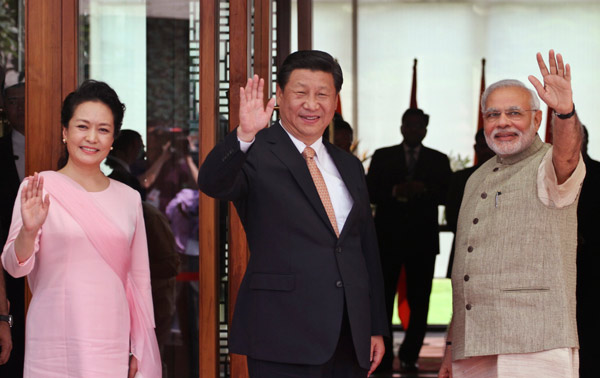How to awake India from its pretend sleep
- By Mao Keji
 0 Comment(s)
0 Comment(s) Print
Print E-mail China.org.cn, April 16, 2015
E-mail China.org.cn, April 16, 2015
|
|
|
President Xi Jinping and his wife, Peng Liyuan, wave after they were received by Indian Prime Minister Narendra Modi upon arrival at a hotel in Ahmedabad, India, Sept 17, 2014. [Photo/China Daily] |
Two pieces of news have drawn the attention of the Chinese public recently. The first one is about the top Vietnam leader's China visit. The General Secretary of the Communist Party of Vietnam (CPV), Nguyen Phu Trong, led a senior delegation to China made up of several members of the CPV Politburo, during which the two countries issued a joint communiqué, pledging a peaceful resolution to maritime disputes. The two countries declared the establishment of a working group on infrastructure cooperation, a working group on monetary cooperation, and a working group for common maritime development.
The other piece of news was about India. India announced that it was implementing the Armed Forces (Special Powers) Act in Arunachal Pradesh, which China claims as part of its southern Tibetan region. Days ago, India's Ministry of Defense announced that it was increasing its military presence in Arunachal Pradesh and deploying 8,000 soldiers there, as well as building 35 new roads, 54 border posts and 72 campsites.
Although China and Vietnam do have maritime disputes, Vietnam is an important country in the latest China's "Road and Belt" initiatives in Southeast Asia. The mutual approach of the two countries shows that neither side wishes to see the disputes undermine significant common interests and the prospect of cooperation.
By contrast, in similar territorial disputes with China, India has failed to make similar efforts to maintain good relations with China. It is an unwise move for New Delhi to allow regional disputes to hinder the two countries' overall strategic interest.
Here comes the question: can China and India make concrete achievements on border issues to create a favorable strategic environment in South Asia for the implementation of the "Belt and Road" initiatives?
From 1981 to 1987, China and India held eight rounds of vice-ministerial meetings on border issues, and from 1989 to 2005, another 15 such talks were held, but none of the negotiations produced a satisfactory result, since the territory involved in the disputes was too large. Acknowledging the stalemate, both governments, in a bid to guarantee a sound bilateral relationship while seeking a quicker solution to the dispute, unveiled two agreements, namely the Agreement on the Maintenance of Peace and Tranquility along the Line of Actual Control in the India-China Border Areas signed in 1993 and the Agreement on Confidence-Building Measures in the Military Field Along the Line of Actual Control in the India-China Border Areas signed in 1996.
Experts on India studies interpreted the implications of the "line of actual control" as follows: First, "no use of force," meaning that both sides must solve border issues peacefully; second, neither party should cross the line on the map as agreed upon by both governments; third, setting aside the problem for a future solution.







Go to Forum >>0 Comment(s)